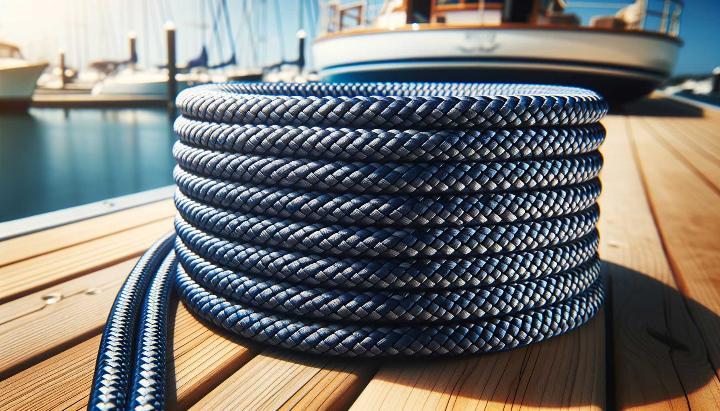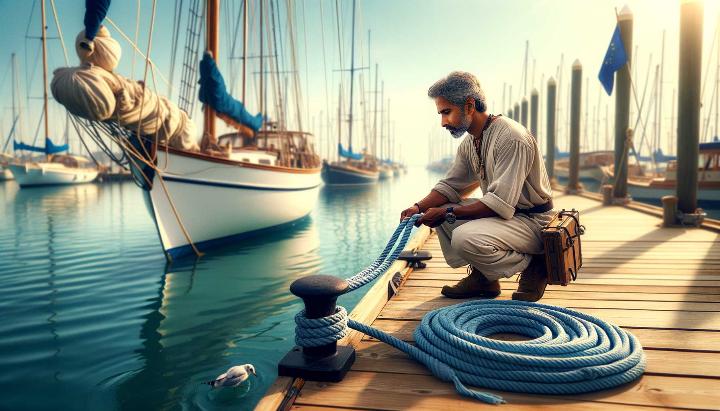Have you ever watched in awe as a seasoned captain effortlessly manoeuvres their vessel into a tight berth, wondering what secret they possess? The answer might surprise you: it's all in the lines. Specifically, double braided nylon dock lines. These unassuming ropes are the unsung heroes of safe and secure docking, and mastering their use can elevate any boater from novice to expert.
At iRopes, we've spent years perfecting the art of rope manufacturing, and we're here to let you in on a little-known fact: the structure of your dock line can make or break your docking experience. Double braided nylon lines aren't just a fancy option; they're a game-changer in the world of boating. With their unique construction of inside and outside braids, these lines offer a level of versatility and performance that single-braid or three-strand ropes simply can't match.
But here's where it gets really interesting: the world of double braided lines goes beyond just nylon. Imagine a rope that combines the strength of nylon with the cutting-edge properties of materials like UHMWPE, KEVLAR, TECHNORA, or VECTRAN. That's the kind of innovation we're bringing to the docking world, and it's revolutionising how experts secure their vessels.
In this post, we'll dive deep into the basics of double braided nylon lines, exploring their structure, advantages, and how to choose the right line for different parts of your hull. Whether you're a seasoned sailor or a weekend warrior, understanding these essentials will not only make your docking experiences smoother but also safer. So, are you ready to unlock the secrets of docking experts and take your boating skills to the next level?
Understanding Double Braid Nylon Dock Lines
As a seasoned sailor, I've learned that the key to a safe and secure docking experience lies in the quality of your dock lines. Double braid nylon dock lines have become the go-to choice for many boating enthusiasts, and for good reason. Let's dive into the fascinating world of these essential boating accessories and explore why they're a cut above the rest.
Structure and Composition of Double Braid Dock Lines
Picture a double braid nylon dock line in your hands. What you're feeling is actually two ropes in one – a braided core nestled snugly inside a braided sheath. This unique construction is what gives these lines their exceptional strength and versatility.
- Core construction: The inner core provides the bulk of the line's strength and load-bearing capacity.
- Outer sheath: This protective layer enhances durability and improves handling characteristics.
- Material composition: While primarily made of nylon, some manufacturers incorporate other materials for enhanced performance.

The beauty of double braid construction lies in its versatility. While pure nylon lines are common, some manufacturers mix in materials like polyester, UHMWPE, KEVLAR, TECHNORA, or VECTRAN to create lines with specific performance characteristics. This flexibility allows boaters to choose lines tailored to their unique needs.
Advantages and Applications of Double Braid Nylon Rope
Having used various types of dock lines over the years, I can confidently say that double braid nylon stands out for several reasons:
- Exceptional strength-to-weight ratio: These lines offer impressive strength without unnecessary bulk.
- Superior shock absorption: Nylon's natural elasticity helps cushion sudden loads, protecting your boat and dock cleats.
- UV and abrasion resistance: The outer sheath provides excellent protection against sun damage and wear.
- Ease of handling: The smooth, flexible nature of double braid lines makes them a joy to work with, even in challenging conditions.
When selecting the right double braid nylon dock line for your boat, consider its size carefully. As a general rule, choose a diameter that's 1/8 inch for every 9 feet of boat length. For instance, a 36-foot boat would typically use 1/2-inch diameter lines.
Pro tip: Always keep spare dock lines on board. You never know when you might need to replace a worn line or assist another boater in need.
Understanding the structure and benefits of double braid nylon dock lines is crucial for any serious boater. By choosing the right lines and maintaining them properly, you'll ensure safer, more secure docking experiences for years to come. In the next section, we'll explore how to select the perfect double braided lines for different parts of your hull.
Advantages of Double Braided Nylon Lines for Docking
As a seasoned sailor, I've come to appreciate the importance of choosing the right dock lines for safe and secure mooring. Double braided nylon lines have become my go-to choice, and for good reason. Let's explore why these lines are a favourite among docking experts and how they can enhance your boating experience.
Strength and Durability of Double Braided Nylon
When it comes to securing your vessel, strength is paramount. Double braided nylon lines excel in this department, offering a robust solution that outperforms many alternatives.
- Superior strength-to-weight ratio: These lines are typically 25-35% stronger than 3-strand ropes of the same diameter, providing excellent holding power without unnecessary bulk.
- Enhanced durability: The double braided construction distributes wear more evenly, resulting in a longer-lasting line that can withstand the rigours of regular use.
- Resistance to UV damage: While no rope is completely immune to sun damage, double braided nylon lines show impressive resilience against UV rays, maintaining their strength over time.
It's worth noting that while double braided lines are generally more chafe-resistant than their 3-strand counterparts, they're not invincible. Always use chafe guards in high-wear areas to prolong the life of your lines.
Handling and Versatility in Various Docking Situations
The true beauty of double braided nylon lines lies in their exceptional handling characteristics and adaptability to different docking scenarios.
- Flexibility and ease of handling: The smooth, pliable nature of these lines makes them a joy to work with, even in challenging conditions. They coil easily and run smoothly through fairleads and cleats.
- Excellent shock absorption: Nylon's natural elasticity helps cushion sudden loads, protecting both your boat and the dock from jarring impacts. This stretching ability is particularly valuable in areas with significant tidal changes or wave action.
- Versatility in docking situations: Whether you're securing your boat in a calm marina or dealing with more dynamic conditions, double braided nylon lines offer the perfect balance of strength and flexibility to keep your vessel safe.

Have you ever struggled with stiff, unwieldy dock lines? The ease of handling that comes with double braided nylon can be a game-changer, especially when you're docking single-handed or in challenging weather conditions.
While double braided nylon lines offer numerous advantages, it's essential to choose the right size and strength for your boat and docking conditions. Remember, the most expensive line isn't always the best choice – it's about finding the right balance for your specific needs.
Pro tip: When selecting double braided nylon lines, aim for a diameter that's roughly 1/8 inch for every 9 feet of boat length. This general rule of thumb ensures adequate strength without overkill.
In my years of boating, I've found that investing in quality double braided nylon lines pays dividends in terms of peace of mind and ease of use. They've become an indispensable part of my docking routine, and I believe they could enhance your boating experience too. Have you made the switch to double braided nylon lines yet? If not, perhaps it's time to consider upgrading your docking setup.
Selecting the Right Double Braided Line for Your Boat
As a seasoned sailor, I've learned that choosing the right double braided line for your boat is crucial for safe and secure docking. Let's dive into the essentials of selecting the perfect line for different parts of your hull, ensuring you're well-equipped for any docking situation.
Understanding Double Braid vs Single Braid and Three-Strand Lines
Before we delve into specific line choices, it's important to understand why double braided lines are often the preferred choice for docking experts. Here's a quick comparison:
- Strength: Double braided lines are typically 25-35% stronger than 3-strand lines of the same diameter, offering superior holding power.
- Durability: The double braid construction distributes wear more evenly, resulting in a longer-lasting line.
- Handling: These lines are smoother and more flexible, making them easier to work with in various docking conditions.

Choosing the Proper Dock Line Size and Length
When it comes to selecting the right double braided line for your boat, size matters. Here's a general guide to help you choose:
- Line diameter: A good rule of thumb is to use 1/8 inch of line diameter for every 9 feet of boat length. For example, a 36-foot boat would typically use 1/2-inch diameter lines.
- Line length: Bow and stern lines should be about 2/3 of your boat's length, while spring lines should be at least as long as your boat.
Remember, these are general guidelines. Factors like your boat's weight, local weather conditions, and specific docking situations may require adjustments. For a deeper understanding of rope performance across different marine scenarios, consider exploring our guide on the top applications of PP rope and Nylon PP rope in docking.
Selecting Lines for Different Parts of the Hull
Now, let's look at how to choose the right double braided lines for specific parts of your hull:
- Bow and stern lines: These should be your strongest lines, as they bear the brunt of the load. I prefer using slightly thicker lines here for added peace of mind.
- Spring lines: These help prevent your boat from moving forward or backward. Use lines that are at least as long as your boat to allow for proper positioning. You may also be interested in our comprehensive guide on mastering rope assembly with polypropylene and mason ropes for enhanced performance.
- Breast lines: These keep your boat parallel to the dock. Choose lines that are about 2/3 the length of your boat for optimal performance.
Pro tip: Always carry spare lines of various lengths and diameters. You never know when you might need to adapt to unexpected docking situations or help out a fellow boater in need.
Matching line strength to your boat size and docking conditions is crucial. Don't be tempted to oversize your lines unnecessarily – this can make them harder to handle and may put excessive strain on your cleats and fairleads. For further insights into double braided nylon rope's versatility, check out our article on exploring the versatility of double braid polypropylene rope.
Have you considered the specific docking challenges in your local area? Tidal changes, frequent strong winds, or crowded marinas might influence your line selection. Take these factors into account when choosing your double braided lines to ensure you're always prepared for a safe and secure docking experience.
Essential Maintenance and Care for Double Braided Nylon Lines
As a lifelong sailor, I've learned that proper maintenance of your double braided nylon lines is just as crucial as choosing the right ones. These resilient ropes are the unsung heroes of safe docking, but even they need some TLC to perform at their best. Let's dive into the essential care routines that will keep your lines ship-shape for years to come.
Proper Cleaning Techniques for Nylon Dock Lines
Cleaning your double braided nylon lines isn't just about aesthetics; it's about preserving their strength and flexibility. Here's my tried-and-true cleaning process:
- Rinse with cold water: After each use, give your lines a thorough rinse with cold freshwater to remove salt, sand, and debris.
- Use mild soap: For stubborn grime, use a gentle, pH-neutral soap. Avoid harsh chemicals that can degrade the nylon fibres.
- Fabric softener trick: Here's a little secret I've picked up over the years - a capful of fabric softener in your wash bucket can help soften the lines and make them more pliable.
- Gentle scrubbing: Use a soft-bristled brush to work out any tough spots, being careful not to damage the fibres.
- Proper drying: Always air-dry your lines in a shaded area. Direct sunlight can weaken nylon over time.

Remember, clean lines are happy lines. Regular cleaning not only keeps your lines looking good but also allows you to inspect them closely for any signs of wear or damage.
Storage and Protection of Double Braided Ropes
Proper storage is key to extending the life of your double braided nylon lines. Here's how I ensure my lines stay in top condition when not in use:
- Clean and dry storage: Always store your lines in a clean, dry place away from direct sunlight and extreme temperatures.
- Coiling technique: Use the figure-eight coiling method to prevent twists and kinks that can weaken the rope over time.
- Avoid damp areas: Never store wet lines in enclosed spaces like lockers, as this can lead to mildew growth and fibre degradation.
- Use rope bags: Invest in breathable rope bags to protect your lines from UV rays and contaminants when not in use.
I've seen too many sailors neglect their lines, only to find them stiff, faded, or weakened when they need them most. Don't let that be you!
Pro tip: Set a reminder to inspect your double braided nylon lines at least once a month. Look for signs of chafing, fraying, or discoloration, especially in high-wear areas like cleats and fairleads.
By following these maintenance practices, you'll not only prolong the life of your double braided nylon lines but also ensure they're ready to perform when you need them most. Remember, a well-maintained line is a reliable line, and in the world of boating, reliability is everything.
Have you established a regular maintenance routine for your dock lines? If not, there's no better time to start than now. Your future self (and your boat) will thank you for it!
Double braided nylon dock lines have become a staple for docking experts, offering unparalleled strength, durability, and versatility. These lines, with a braided core and sheath, can integrate other materials like polyester, UHMWPE, KEVLAR, TECHNORA, and VECTRAN for tailored performance. They excel in shock absorption, UV resistance, and ease of handling, making them ideal for various parts of a vessel's hull, from bow to stern. Proper maintenance and line selection ensure longevity and safety, enhancing your docking routine with reliability and peace of mind.
Explore Your Custom Rope Solutions
Above is our inquiry form—fill it out to connect with iRopes and explore custom solutions that meet your unique docking needs. Whether you're upgrading to a double braided line or simply seeking advice, we're here to help make your boating experiences safer and more enjoyable.